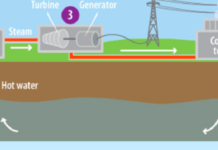Columbia Environmental Research Center scientist Donald Tillitt has found sturgeon in the Missouri River with both male and female sex organs. While the reason for these “intersex” fish is not known, researchers suspect the growing concentrations of pharmaceutical and personal care products (PPCP’s) entering water systems might be a cause.

According to the Environmental Protection Agency (EPA), PPCP’s are “any product used by individuals for personal health or cosmetic reasons or used by agribusiness to enhance growth or health of livestock. PPCP’s comprise a diverse collection of thousands of chemical substances, including prescription and over-the-counter therapeutic drugs, veterinary drugs, fragrances, and cosmetics.”
PPCPs include medications like birth control, antibiotics, caffeine, animal pharmaceuticals, mood stabilizers and sex hormones. When they are taken into the human body, these pharmaceutical do not fully break down. The medication is excreted and enters the water system. These PPCP’s also end up in the water system when medications are flushed down the toilet for disposal. For a long time, that was the proper directed way of getting rid of excess pharmaceuticals.
Now, tests show that those PPCP’s that are flushed down the toilet are entering the water supply and are not being removed during water purification processes. Although wastewater treatment centers use many steps to purify water, these centers are not regulated to remove the PPCP’s.
"The systems that most treatment plants use today, including the Columbia Regional Wastewater Treatment Plant do not effectively remove chemical compounds from water," said Craig Cuvellier, a laboratory supervisor who works at the Columbia plant. The cost to fix this issue is currently unknown. This water from the plant is used for agricultural, drinking and release back into streams and rivers.
This is an issue that is become more and more obvious in the aquatic life. In Tillitt’s study, he saw ovary tissue growing around testicular tissue. It had fully developed sex organs of both a male and a female sturgeon.
“We know the PPCP’s are in the water but, there is no real way of saying that is that is 100% the reason why [the fish had male and female sex organs],” said Tillit.
Humans and fish have similar reproductive hormones, therefore the chemicals that humans use will most likely have the same impact on fish, depending on the exposure. Because of their effects, these chemicals are known as endocrine disrupters.
If the pharmaceuticals in the wastewater are having this many effects on aquatic species what does that look like for humans? “The small amount of PPCP’s in water is not harmful to humans or else it would have been regulated,” said Cuvellier.
| Related story: From toilet to table |
According to the Food and Drug Administration, the Department of Health and Human Services and EPA jointly released revised guidelines in October 2009, which explain how to get rid of unwanted, old or unused pharmaceuticals. Proper disposal would be to take these pharmaceuticals to “waste take back locations.” If you are unable to reach these locations, you can also take pharmaceuticals out of their original containers, mix the drugs with an undesirable substance like used coffee grounds or kitty litter, put it in a sealable container, and throw it in the trash. This is a safe was to dispose of unwanted pharmaceuticals. Emily Phelps

This work is licensed under a Creative Commons Attribution-NonCommercial-NoDerivs 3.0 Unported License














This topic is a very unique one and is also one that many people would want to be interested in because of the rarity in its text. I like this article, keep up the good work please.
i didnt know that thanks for the info:smile keep up the jolly good work